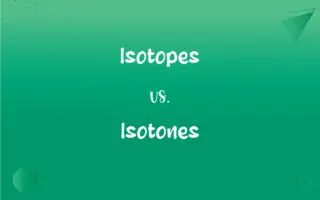Epicenter vs. Hypocenter: What's the Difference?
Edited by Janet White || By Harlon Moss || Published on December 30, 2023
The epicenter is the Earth's surface directly above an earthquake's origin, while the hypocenter is the actual location beneath the surface where the earthquake starts.

Key Differences
The epicenter is the point on the Earth's surface directly above the earthquake's focus. The hypocenter, however, is the precise underground point where seismic waves originate during an earthquake.
During an earthquake, the epicenter is the most commonly referenced location for reporting. In contrast, the hypocenter, being below the surface, denotes the actual location of the earthquake's start.
The epicenter is crucial for assessing potential surface damage and is used in news reports and studies. The hypocenter, on the other hand, is vital for understanding the earthquake's depth and geological characteristics.
Seismologists locate the epicenter to predict the affected areas on the surface. The hypocenter's depth, conversely, helps determine the earthquake's intensity and potential aftershocks.
In mapping earthquakes, the epicenter provides a surface reference point. Meanwhile, the hypocenter gives geologists insight into tectonic movements and stresses in the Earth's crust.
ADVERTISEMENT
Comparison Chart
Location
Earth's surface directly above the earthquake
Actual underground origin of the earthquake
Reference in Reporting
Commonly used in news and reports
Less frequently mentioned, but crucial for scientific understanding
Role in Damage Assessment
Assesses surface damage and affected areas
Determines earthquake depth and intensity
Importance in Seismology
Used for emergency response and public information
Key for studying tectonic movements and seismic activity
Relation to Earthquake
Indirectly impacted by seismic waves
Direct source of seismic waves
ADVERTISEMENT
Epicenter and Hypocenter Definitions
Epicenter
Epicenter refers to the surface location above the start of seismic activity.
News reports focused on the epicenter for damage assessments.
Hypocenter
The hypocenter is the precise underground location where an earthquake starts.
The earthquake's hypocenter was 10 kilometers deep.
Epicenter
The epicenter is the surface projection of an earthquake's underground start.
The epicenter experienced the strongest shaking during the earthquake.
Hypocenter
Hypocenter refers to the actual origin point of seismic waves beneath the Earth's surface.
Scientists analyzed the hypocenter to understand the quake's cause.
Epicenter
The epicenter is the ground point above where an earthquake begins underground.
Relief efforts were concentrated around the epicenter.
Hypocenter
The hypocenter is the subsurface point of an earthquake's initiation.
The depth of the hypocenter influenced the quake's intensity.
Epicenter
The epicenter is the point on the Earth's surface directly above an earthquake's origin.
The epicenter of the quake was near the coastal city.
Hypocenter
The hypocenter is the focal point of an earthquake beneath the Earth's crust.
Geologists studied the hypocenter to predict future seismic patterns.
Epicenter
Epicenter denotes the Earth's surface location above an earthquake's hypocenter.
Seismologists quickly identified the epicenter of the tremor.
Hypocenter
Hypocenter denotes the initial rupture point of an earthquake underground.
The hypocenter's depth was unusual for the region's seismic activity.
Epicenter
The point on the earth's surface directly above the focus of an earthquake.
Hypocenter
The surface position directly beneath the center of a nuclear explosion.
Epicenter
The focal point of a usually harmful or unpleasant phenomenon or event; the center
Stood at the epicenter of the international crisis.
Hypocenter
(US) hypocentre
Epicenter
(American spelling) epicentre
Epicenter
(American spelling) epicentre
Epicenter
The point on the Earth's surface directly above the focus of an earthquake
FAQs
How is the hypocenter related to an earthquake?
The hypocenter is the actual underground location where an earthquake originates.
Can the epicenter and hypocenter be at the same place?
No, the epicenter is always at the surface, while the hypocenter is below ground.
How do scientists locate the hypocenter?
Scientists use seismic wave data to triangulate the hypocenter's location.
Why is the epicenter important in earthquake reporting?
The epicenter is important for understanding which surface areas are affected by the earthquake.
Does the depth of the hypocenter affect earthquake strength?
Yes, deeper hypocenters generally result in less surface damage.
Can an earthquake have multiple hypocenters?
Large earthquakes can have complex rupture processes with multiple hypocenters.
What is the epicenter of an earthquake?
The epicenter is the point on Earth's surface directly above where an earthquake starts underground.
Is the damage always worst at the epicenter?
Often, but not always, as other factors like soil type and building structures play a role.
Are the epicenter and hypocenter the same in all types of earthquakes?
No, their positions vary depending on the earthquake's geological characteristics.
Is the epicenter useful for predicting aftershocks?
Yes, it helps in estimating potential areas for aftershocks.
Can the hypocenter be at the surface?
No, the hypocenter is always below the surface of the Earth.
Do all earthquakes have a clearly defined hypocenter?
Most do, but in complex cases, defining a single hypocenter can be challenging.
Does the epicenter location change with aftershocks?
Yes, each aftershock has its own epicenter and hypocenter.
Can there be multiple epicenters for a single earthquake?
No, each earthquake has one epicenter, but complex events may have several segments with their own epicenters.
Are the epicenter and hypocenter always vertically aligned?
Generally, yes, but geological complexities can cause variations.
Do the epicenter and hypocenter move over time?
No, they are fixed points related to a specific earthquake event.
Can technology precisely locate the hypocenter?
Modern seismology can accurately locate the hypocenter, but some margin of error remains.
How deep can a hypocenter be?
Hypocenters can vary greatly in depth, from very shallow to several hundred kilometers deep.
Is the epicenter important for emergency response?
Yes, it helps direct emergency services to the most affected areas.
How quickly can an epicenter be determined after an earthquake?
With modern technology, almost immediately after the seismic waves are detected.
About Author
Written by
Harlon MossHarlon is a seasoned quality moderator and accomplished content writer for Difference Wiki. An alumnus of the prestigious University of California, he earned his degree in Computer Science. Leveraging his academic background, Harlon brings a meticulous and informed perspective to his work, ensuring content accuracy and excellence.
Edited by
Janet WhiteJanet White has been an esteemed writer and blogger for Difference Wiki. Holding a Master's degree in Science and Medical Journalism from the prestigious Boston University, she has consistently demonstrated her expertise and passion for her field. When she's not immersed in her work, Janet relishes her time exercising, delving into a good book, and cherishing moments with friends and family.






































































